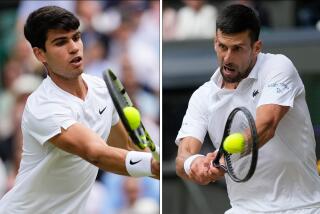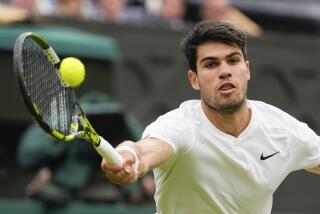TENNIS / BILL DWYRE : No Glory at Grotto for Brad Pearce This Year
WIMBLEDON, England — Wimbledon is so fickle. When it giveth, it does so in the grandest of fashion, courting you with its charming Centre Court and soft, sensual grass. And when it taketh away, it does so abruptly, with a quick shrug of its shoulders.
This is the Grotto. Other places hold tennis tournaments, but the one they hold here is a summit meeting. Nothing in tennis is bigger than this, no single player, no single match or moment. Indeed, so much history here, so many fleeting moments, never make the roll calls.
In 1990, Wimbledon gaveth to young Brad Pearce, putting its arm around him and escorting him into its inner circle. Friday afternoon, on a back court, well away from that inner circle, Wimbledon tooketh away. Pearce lost in the first round to a qualifier named Gianluca Pozzi of Italy, 4-6, 6-3, 6-2, 6-2.
Last year at the Grotto, the 24-year-old Pearce played a qualifier named Ronnie Bathman, on a back court. He lost a set in that, his first-round match, then started a four-match run that put him into the quarterfinals and onto Centre Court against Ivan Lendl. Suddenly, the tennis world wanted to know all about this Pearce fellow.
And so it was told: He was from the non-tennis Mecca of Provo, Utah; had been an All-American at UCLA in his freshman and sophomore seasons, and had lost to Stanford’s Dan Goldie in the NCAA semifinals in 1986.
Other than lots of junior tournament titles and the strong showing in the NCAA tournament, Pearce’s best moment in tennis before walking onto Centre Court with Lendl was probably winning the Pacific 10 singles title at Ojai, where the likes of Connors and McEnroe and Ashe and Pasarell had played and excelled before him and where tradition, although on a local level, is nearly as big a thing as it is at Wimbledon.
Until Pearce’s moment with Lendl, he had pretty much survived on the tour on money won in doubles with partners who were former college teammates or opponents from the Pac-10.
His quarterfinal match against Lendl was respectable. He went out in four sets, winning the third, 7-5, and losing the three others at 6-4.
Brad Pearce, the newcomer, had not gone quickly, or easily. But he had gone, and at the Grotto, that is what eventually counts.
“I was pleased that I didn’t go out there and get overwhelmed,” Pearce said. “I didn’t just play and collect some grass and go home.”
Friday, while Pearce struggled to slap back the darting, skidding serves of the left-hander Pozzi on Court 8, he and Lendl were, once again, within close range of one another--but light-years apart.
From Court 8, the mighty walls of both Court 1 and Centre Court loomed in the distance, with the thick ivy on Centre Court surrounding a scoreboard that told of Lendl’s early lead against Kelly Evernden. Moments after Pozzi had tapped back a match-point volley, the scoreboard flashed Lendl’s 6-2 first set.
“This place is like no other,” Pearce said afterward. “Everybody here is good. Everybody here is capable of doing what I did last year. And all the players are capable of struggling in the first round, like I did this year.”
At first, Pearce said he didn’t think a lot about the Lendl match last year, but as he talked more, it was clear he did.
“Sure, I’m proud of the fact that I was there in the quarterfinals,” he said. “I’d like to be there again someday, but I’m competitive, like everybody else, and you can’t help thinking about maybe going one round better.
“But, yes, being there, on Centre Court, was a real thrill.
“You know, that’s the only court in the world in which I actually enjoy tennis spectating. There’s a special air out there, something that raises your level when you play.
“All these years, when you live on the West Coast, and you turn on the TV to watch at 6 a.m., and then, all of a sudden, you are out there yourself . . . “
And all of a sudden, you are out of it. Riding high in April, shot down in May. It’s like that at Wimbledon, that fickle Grotto.
It is strange how long it takes many of these players, such a favored few in the world of professional athletics, to realize what they have.
Obviously, it’s an age thing--so many make it so big so early in their lives. The contrast here is particularly revealing.
On one hand, there is Monica Seles, still six months shy of her 18th birthday, apparently thumbing her nose at the tradition and very fabric of the sport that made her a multimillionaire, with her unexplained dropout from Wimbledon and a Grand Slam pursuit.
On the other hand, there is Jimmy Connors, once brash and brazen both on and off the court, but now the sport’s elder statesman.
Friday, when Connors opened with a straight-set victory after having been away from here for two years because of various injuries, he spoke with the perspective of a soon-to-be 39-year old.
Asked what he liked best about the way he played, he said: “Just being out there was good enough.”
The Andre Agassi striptease, down to his whitest whites, was still the talk of the town called Wimbledon Friday. It seemed that just about every reporter worth the price of his lap-top computer tried his hand at describing this, and Simon Barnes of the Times of London was especially agog, as they say here.
Wrote Barnes: “Andre Agassi took off his trousers on Centre Court yesterday. I was there, children, I was there. He turned to meet his public, smirking uneasily, looking radiant as a young bride in his virginal white. To be more accurate, he looked radiant as a young wedding cake in his silly three-tiered outfit: baggy shirt, baggy shorts, cycle shorts.”
More to Read
Go beyond the scoreboard
Get the latest on L.A.'s teams in the daily Sports Report newsletter.
You may occasionally receive promotional content from the Los Angeles Times.











